Global Transcriptome Profiling Identified Transcription Factors, Biological Process, and Associated Pathways for Pre-Harvest Aflatoxin Contamination in Groundnut
Abstract
1. Introduction
2. Material and Methods
2.1. Plant and Fungal Material
2.2. Experimental Setup
2.3. Aflatoxin Quantification in Control and Infected Samples
2.4. RNA Extraction, Illumina Sequencing and Data Pre-Processing
2.5. Trimming, Alignment and Functional Annotation of Sequences
2.6. Transcript Annotations, Pathway Assignment and Annotations of Transcription Factors
3. Results
3.1. Transcriptome Sequencing and Gene Expression Analysis
3.2. Clustering and Principal Component Analysis
3.3. Differential Expressed Genes under Control and Infected Conditions
3.4. Functional Annotations and GO Assignment
3.5. Spatial Transcript Expression and Identification of Transcription under Control and Infected Conditions
3.6. Pathways Genes Affecting during Host–Pathogen Interaction
4. Discussion
Supplementary Materials
Author Contributions
Funding
Institutional Review Board Statement
Informed Consent Statement
Data Availability Statement
Acknowledgments
Conflicts of Interest
References
- Perrone, G.; Haidukowski, M.; Stea, G.; Epifani, F.; Bandyopadhyay, R.; Leslie, J.F.; Logrieco, A. Population structure and Aflatoxin production by Aspergillus Sect. Flavi from maize in Nigeria and Ghana. Food Microbiol. 2014, 41, 52–59. [Google Scholar] [CrossRef] [PubMed]
- Pandey, M.K.; Kumar, R.; Pandey, A.K.; Soni, P.; Gangurde, S.S.; Sudini, H.K.; Fountain, J.C.; Liao, B.; Desmae, H.; Okori, P.; et al. Mitigating aflatoxin contamination in groundnut through a combination of genetic resistance and post-harvest management practices. Toxins 2019, 11, 315. [Google Scholar] [CrossRef]
- Gong, Y.; Hounsa, A.; Egal, S.; Turner, P.C.; Sutcliffe, A.E.; Hall, A.J.; Cardwell, K.; Wild, C.P. Postweaning exposure to aflatoxin results in impaired child growth: A longitudinal study in Benin, West Africa. Environ. Health Perspect. 2004, 112, 1334–1338. [Google Scholar] [CrossRef] [PubMed]
- Sahoo, P.; Mukherjee, S. Effect of dietary β-1,3 glucan on immune responses and disease resistance of healthy and aflatoxin B1-induced immunocompromised rohu (Labeo rohita Hamilton). Fish Shellfish. Immunol. 2001, 11, 683–695. [Google Scholar] [CrossRef] [PubMed]
- Jolly, P.E. Aflatoxin: Does it contribute to an increase in HIV viral load? Future Microbiol. 2014, 9, 121–124. [Google Scholar] [CrossRef] [PubMed]
- Wild, C.P.; Montesano, R. A model of interaction: Aflatoxins and hepatitis viruses in liver cancer aetiology and prevention. Cancer Lett. 2009, 286, 22–28. [Google Scholar] [CrossRef]
- Strosnider, H.; Azziz-Baumgartner, E.; Banziger, M.; Bhat, R.V.; Breiman, R.; Brune, M.-N.; Decock, K.; Dilley, A.; Groopman, J.; Hell, K.; et al. Workgroup report: Public health strategies for reducing aflatoxin exposure in developing countries. Environ. Health Perspect. 2006, 114, 1898–1903. [Google Scholar] [CrossRef]
- Benkerroum, N. Chronic and acute toxicities of aflatoxins: Mechanisms of action. Int. J. Environ. Res. Public Health 2020, 17, 423. [Google Scholar] [CrossRef]
- Nayak, S.N.; Agarwal, G.; Pandey, M.K.; Sudini, H.K.; Jayale, A.S.; Purohit, S.; Desai, A.; Wan, L.; Guo, B.; Liao, B.; et al. Aspergillus flavus infection triggered immune responses and host–pathogen cross-talks in groundnut during in-vitro seed colonization. Sci. Rep. 2017, 7, 1–14. [Google Scholar] [CrossRef]
- Soni, P.; Gangurde, S.S.; Ortega-Beltran, A.; Kumar, R.; Parmar, S.; Sudini, H.K.; Lei, Y.; Ni, X.; Huai, D.; Fountain, J.C.; et al. Functional biology and molecular mechanisms of host–pathogen interactions for aflatoxin contamination in groundnut (Arachis hypogaea L.) and maize (Zea mays L.). Front. Microbiol. 2020, 11, 227. [Google Scholar] [CrossRef]
- Upadhyaya, H.D.; Nigam, S.N.; Thakur, R.P. Genetic enhancement for resistance to aflatoxin contamination in groundnut. In Proceedings of the Seventh ICRISAT Regional Groundnut Meeting for Western and Central Africa, Cotonu, Benin, 6–8 December 2000; International Crops Research Institute for the Semi-Arid Tropics: Patancheru, India, 2002; pp. 29–36. [Google Scholar]
- Waliyar, F.; Kumar, P.L.; Traoré, A.; Ntare, B.R.; Diarra, B.; Kodio, O. Pre and post-harvest management of aflatoxin contamination in peanuts. In Mycotoxins: Detection Methods, Management, Public Health and Agricultural Trade; Leslie, J.F., Bandyopadhyay, R., Visconti, A., Eds.; CABI: Wallingford, UK, 2008; pp. 209–218. [Google Scholar]
- Waliyar, F.; Umeh, V.; Traore, A.; Osiru, M.; Ntare, B.; Diarra, B.; Kodio, O.; Kumar, K.V.K.; Sudini, H. Prevalence and distribution of aflatoxin contamination in groundnut (Arachis hypogaea L.) in Mali, West Africa. Crop Prot. 2015, 70, 1–7. [Google Scholar] [CrossRef]
- Guo, B.; Chen, Z.-Y.; Lee, R.D.; Scully, B.T. Drought stress and preharvest aflatoxin contamination in agricultural commodity: Genetics, genomics and proteomics. J. Integr. Plant Biol. 2008, 50, 1281–1291. [Google Scholar] [CrossRef] [PubMed]
- Fountain, J.C.; Khera, P.; Yang, L.; Nayak, S.N.; Scully, B.T.; Lee, R.D.; Chen, Z.-Y.; Kemerait, R.C.; Varshney, R.; Guo, B. Resistance to Aspergillus flavus in maize and peanut: Molecular biology, breeding, environmental stress, and future perspectives. Crop J. 2015, 3, 229–237. [Google Scholar] [CrossRef]
- Holbrook, C.C.; Kvien, C.K.; Rucker, K.S.; Wilson, D.M.; Hook, J.E.; Matheron, M.E. Preharvest aflatoxin contamination in drought-tolerant and drought-intolerant peanut genotypes1. Peanut Sci. 2000, 27, 45–48. [Google Scholar] [CrossRef]
- Nigam, S.N.; Waliyar, F.; Aruna, R.; Reddy, S.V.; Kumar, P.L.; Craufurd, P.Q.; Diallo, A.T.; Ntare, B.R.; Upadhyaya, H.D. Breeding peanut for resistance to aflatoxin contamination at ICRISAT. Peanut Sci. 2009, 36, 42–49. [Google Scholar] [CrossRef]
- Girdthai, T.; Jogloy, S.; Vorasoot, N.; Akkasaeng, C.; Wongkaew, S.; Holbrook, C.C.; Patanothai, A. Associations between physiological traits for drought tolerance and aflatoxin contamination in peanut genotypes under terminal drought. Plant Breed. 2010, 129, 693–699. [Google Scholar] [CrossRef]
- Dorner, J.W.; Cole, R.J.; Sanders, T.H.; Blankenship, P.D. Interrelationship of kernel water activity, soil temperature, maturity, and phytoalexin production in pre-harvest aflatoxin contamination of drought-stressed peanuts. Mycopathology 1989, 105, 117–128. [Google Scholar] [CrossRef]
- Waliyar, F.; Traoré, A.; Fatondji, D.; Ntare, B.R. Effect of irrigation interval, planting date, and cultivar on Aspergillus flavus and aflatoxin contamination of peanut in a sandy soil of Niger. Peanut Sci. 2003, 30, 79–84. [Google Scholar] [CrossRef]
- Clevenger, J.; Marasigan, K.; Liakos, V.; Sobolev, V.; Vellidis, G.; Holbrook, C.; Ozias-Akins, P. RNA sequencing of contaminated seeds reveals the state of the seed permissive for pre-harvest aflatoxin contamination and points to a potential susceptibility factor. Toxins 2016, 8, 317. [Google Scholar] [CrossRef]
- Martin, J.A.; Wang, Z. Next-generation transcriptome assembly. Nat. Rev. Genet. 2011, 12, 671–682. [Google Scholar] [CrossRef]
- Payton, P.; Kottapalli, K.R.; Rowland, D.; Faircloth, W.; Guo, B.; Burow, M.; Puppala, N.; Gallo, M. Gene expression profiling in peanut using high density oligonucleotide microarrays. BMC Genom. 2009, 10, 265. [Google Scholar] [CrossRef] [PubMed]
- Guo, B.; Fedorova, N.D.; Chen, X.; Wan, C.-H.; Wang, W.; Nierman, W.C.; Bhatnagar, D.; Yu, J. Gene expression profiling and identification of resistance genes to Aspergillus flavus infection in peanut through EST and microarray strategies. Toxins 2011, 3, 737–753. [Google Scholar] [CrossRef] [PubMed]
- Zhang, J.; Liang, S.; Duan, J.; Wang, J.; Chen, S.; Cheng, Z.; Li, Y. De novo assembly and characterization of the transcriptome during seed development, and generation of genic-SSR markers in peanut (Arachis hypogaea L.). BMC Genom. 2012, 13, 90. [Google Scholar] [CrossRef]
- Xia, H.; Zhao, C.; Hou, L.; Li, A.; Zhao, S.; Bi, Y.; An, J.; Zhao, Y.; Wan, S.; Wang, X. Transcriptome profiling of peanut gynophores revealed global reprogramming of gene expression during early pod development in darkness. BMC Genom. 2013, 14, 517. [Google Scholar] [CrossRef] [PubMed]
- Wang, H.; Lei, Y.; Wan, L.; Yan, L.; Lv, J.; Dai, X.; Ren, X.; Guo, W.; Jiang, H.; Liao, B. Comparative transcript profiling of resistant and susceptible peanut post-harvest seeds in response to aflatoxin production by Aspergillus flavus. BMC Plant Biol. 2016, 16, 1–16. [Google Scholar] [CrossRef]
- Bertioli, S.C.M.L.; Cannon, S.B.; Froenicke, L.; Huang, G.; Farmer, A.D.; Cannon, E.K.S.; Liu, X.; Gao, D.; Clevenger, J.; Dash, S.; et al. The genome sequences of Arachis duranensis and Arachis ipaensis, the diploid ancestors of cultivated peanut. Nat. Genet. 2016, 48, 438–446. [Google Scholar] [CrossRef] [PubMed]
- Chen, X.; Li, H.; Pandey, M.K.; Yang, Q.; Wang, X.; Garg, V.; Li, H.; Chi, X.; Doddamani, D.; Hong, Y.; et al. Draft genome of the peanut A-genome progenitor (Arachis duranensis) provides insights into geocarpy, oil biosynthesis, and allergens. Proc. Natl. Acad. Sci. USA 2016, 113, 6785–6790. [Google Scholar] [CrossRef] [PubMed]
- Bertioli, D.J.; Jenkins, J.; Clevenger, J.; Dudchenko, O.; Gao, D.; Seijo, G.; Leal-Bertioli, S.C.M.; Ren, L.; Farmer, A.D.; Pandey, M.K.; et al. The genome sequence of segmental allotetraploid peanut Arachis hypogaea. Nat. Genet. 2019, 51, 877–884. [Google Scholar] [CrossRef]
- Chen, X.; Lu, Q.; Liu, H.; Zhang, J.; Hong, Y.; Lan, H.; Li, H.; Wang, J.; Liu, H.; Li, S.; et al. Sequencing of cultivated peanut, Arachis hypogaea, yields insights into genome evolution and oil improvement. Mol. Plant 2019, 12, 920–934. [Google Scholar] [CrossRef]
- Zhuang, W.; Chen, H.; Yang, M.; Wang, J.; Pandey, M.K.; Zhang, C.; Chang, W.C.; Zhang, L.; Zhang, X.; Tang, R.; et al. The Arachis hypogaea genome elucidates legume karyotypes, polyploid evolution and crop domestication. Nat. Genet. 2019, 51, 865–876. [Google Scholar] [CrossRef]
- Varshney, R.K.; Pandey, M.K.; Bohra, A.; Singh, V.K.; Thudi, M.; Saxena, R.K. Toward the sequence-based breeding in legumes in the post-genome sequencing era. Theor. Appl. Genet. 2019, 132, 797–816. [Google Scholar] [CrossRef]
- Pandey, M.K.; Pandey, A.K.; Kumar, R.; Nwosu, V.; Guo, B.; Wright, G.; Bhat, R.S.; Chen, X.; Bera, S.K.; Yuan, M.; et al. Translational genomics for achieving higher genetic gains in post-genome era in groundnut. Theor. Appl. Genet. 2020, 133, 1679–1702. [Google Scholar] [CrossRef]
- Pandey, M.K.; Roorkiwal, M.; Singh, V.; Lingam, A.; Kudapa, H.; Thudi, M.; Chitikineni, A.; Rathore, A.; Varshney, R.K. Emerging genomic tools for legume breeding: Current status and future perspectives. Front. Plant Sci. 2016, 7, 455. [Google Scholar] [CrossRef]
- Waliyar, F.; Reddy, S.V.; Kumar, P.L. Estimation of Aspergillus flavus infection and aflatoxin contamination in seeds. In Laboratory Manual; International Crops Research Institute for the Semi-Arid Tropics: Patancheru, India, 2005; pp. 26–27. [Google Scholar]
- Katta, M.A.V.S.K.; Khan, A.W.; Doddamani, D.; Thudi, M.; Varshney, R.K. NGS-QCbox and Raspberry for parallel, automated and rapid quality control analysis of large-scale next generation sequencing (Illumina) data. PLoS ONE 2015, 10, e0139868. [Google Scholar] [CrossRef]
- Bolger, A.M.; Lohse, M.; Usadel, B. Trimmomatic: A flexible trimmer for Illumina sequence data. Bioinformatics 2014, 30, 2114–2120. [Google Scholar] [CrossRef] [PubMed]
- Clevenger, J.P.; Chu, Y.; Scheffler, B.; Ozias-Akins, P. A Developmental transcriptome map for allotetraploid Arachis hypogaea. Front. Plant Sci. 2016, 7, 1446. [Google Scholar] [CrossRef] [PubMed]
- Kim, D.; Pertea, G.; Trapnell, C.; Pimentel, H.; Kelley, R.; Salzberg, S.L. TopHat2: Accurate alignment of transcriptomes in the presence of insertions, deletions and gene fusions. Genome Biol. 2013, 14, R36. [Google Scholar] [CrossRef]
- Grabherr, M.G.; Haas, B.J.; Yassour, M.; Levin, J.Z.; Thompson, D.A.; Amit, I.; Adiconis, X.; Fan, L.; Raychowdhury, R.; Zeng, Q.; et al. Trinity: Reconstructing a full-length transcriptome without a genome from RNA-Seq data. Nat. Biotechnol. 2011, 29, 644. [Google Scholar] [CrossRef] [PubMed]
- Gilbert, D. EvidentialGene: Tr2aacds, Mrna Transcript Assembly Software. 2013. Available online: http://arthropods.eugenes.org/EvidentialGene (accessed on 27 July 2020).
- Trapnell, C.; Williams, B.A.; Pertea, G.; Mortazavi, A.; Kwan, G.; Van Baren, M.J.; Salzberg, S.L.; Wold, B.J.; Pachter, L. Transcript assembly and quantification by RNA-Seq reveals unannotated transcripts and isoform switching during cell differentiation. Nat. Biotechnol. 2010, 28, 511–515. [Google Scholar] [CrossRef]
- Conesa, A.; Götz, S.; García-Gómez, J.M.; Terol, J.; Talón, M.; Robles, M. Blast2GO: A universal tool for annotation, visualization and analysis in functional genomics research. Bioinformatics 2005, 21, 3674–3676. [Google Scholar] [CrossRef]
- Yanai, I.; Benjamin, H.; Shmoish, M.; Chalifa-Caspi, V.; Shklar, M.; Ophir, R.; Bar-Even, A.; Horn-Saban, S.; Safran, M.; Domany, E.; et al. Genome-wide midrange transcription profiles reveal expression level relationships in human tissue specification. Bioinformatics 2004, 21, 650–659. [Google Scholar] [CrossRef] [PubMed]
- Jin, J.; Zhang, H.; Kong, L.; Gao, G.; Luo, J. PlantTFDB 3.0: A portal for the functional and evolutionary study of plant transcription factors. Nucleic Acids Res. 2014, 42, D1182–D1187. [Google Scholar] [CrossRef] [PubMed]
- Jayashree, T.; Subramanyam, C. Oxidative stress as a prerequisite for aflatoxin production by Aspergillus parasiticus. Free Radic. Biol. Med. 2000, 29, 981–985. [Google Scholar] [CrossRef]
- Bhattacharjee, S. Reactive oxygen species and oxidative burst: Roles in stress, senescence and signal transducation in plants. Curr. Sci. 2005, 89, 1113–1121. [Google Scholar]
- Roze, L.V.; Hong, S.-Y.; Linz, J.E. Aflatoxin biosynthesis: Current frontiers. Annu. Rev. Food Sci. Technol. 2013, 4, 293–311. [Google Scholar] [CrossRef] [PubMed]
- Yang, L.; Fountain, J.C.; Wang, H.; Ni, X.; Ji, P.; Lee, R.D.; Kemerait, R.C.; Scully, B.T.; Guo, B. Stress sensitivity is associated with differential accumulation of reactive oxygen and nitrogen species in maize genotypes with contrasting levels of drought tolerance. Int. J. Mol. Sci. 2015, 16, 24791–24819. [Google Scholar] [CrossRef]
- Yang, L.; Fountain, J.C.; Chu, Y.; Ni, X.; Lee, R.D.; Kemerait, R.C.; Guo, B. Differential accumulation of reactive oxygen and nitrogen species in maize lines with contrasting drought tolerance and aflatoxin resistance. Phytopathology 2016, 106, S2.16. [Google Scholar]
- Singh, K.B.; Foley, R.C.; Oñate-Sánchez, L. Transcription factors in plant defense and stress responses. Curr. Opin. Plant Biol. 2002, 5, 430–436. [Google Scholar] [CrossRef]
- Durrant, W.; Dong, X. Systemic acquired resistance. Annu. Rev. Phytopathol. 2004, 42, 185–209. [Google Scholar] [CrossRef]
- Mandal, P. An overview of systemic acquired resistance (sar), a signal transduction pathway of plant defense. Rev. Res. 2019, 8, 1–7. [Google Scholar]
- Kunkel, B.N.; Brooks, D.M. Cross talk between signaling pathways in pathogen defense. Curr. Opin. Plant Biol. 2002, 5, 325–331. [Google Scholar] [CrossRef]
- Fountain, J.C.; Bajaj, P.; Nayak, S.N.; Yang, L.; Pandey, M.K.; Kumar, V.; Jayale, A.S.; Chitikineni, A.; Lee, R.D.; Kemerait, R.C.; et al. Responses of Aspergillus flavus to oxidative stress are related to fungal development regulator, antioxidant enzyme, and secondary metabolite biosynthetic gene expression. Front. Microbiol. 2016, 7, 2048. [Google Scholar] [CrossRef]
- Doehlemann, G.; Ökmen, B.; Zhu, W.; Sharon, A. Plant pathogenic fungi. Mycologia 2017, 79, 1–23. [Google Scholar]
- Dolezal, A.L.; Eshu, X.; Obrian, G.R.; Nielsen, D.; Woloshuk, C.P.; Boston, R.S.; Payne, G.A. Aspergillus flavus infection induces transcriptional and physical changes in developing maize kernels. Front. Microbiol. 2014, 5, 384. [Google Scholar] [CrossRef]
- Jiang, L.; Wu, J.; Fan, S.; Li, W.; Dong, L.; Cheng, Q.; Xu, P.; Zhang, S. Isolation and characterization of a novel pathogenesis-related protein gene (GmPRP) with induced expression in soybean (Glycine max) during Infection with Phytophthora sojae. PLoS ONE 2015, 10, e0129932. [Google Scholar] [CrossRef] [PubMed]
- Bala, M.; Radhakrishnan, T.; Kumar, A.; Mishra, G.P.; Dobraia, J.R.; Kirti, P.B. Erratum: Overexpression of a fusion defensin gene from radish and fenugreek improves resistance against leaf spot diseases caused by Cercospora arachidicola and Phaeoisariopsis personata in peanut. Turk. J. Boil. 2019, 43, 154. [Google Scholar] [CrossRef] [PubMed]
- Sharma, K.K.; Pothana, A.; Prasad, K.; Shah, D.; Kaur, J.; Bhatnagar, D.; Chen, Z.-Y.; Raruang, Y.; Cary, J.W.; Rajasekaran, K.; et al. Peanuts that keep aflatoxin at bay: A threshold that matters. Plant Biotechnol. J. 2017, 16, 1024–1033. [Google Scholar] [CrossRef]
- Liu, J.; Osbourn, A.; Ma, P. MYB Transcription factors as regulators of phenylpropanoid metabolism in plants. Mol. Plant 2015, 8, 689–708. [Google Scholar] [CrossRef] [PubMed]
- Mierziak, J.; Kostyn, K.; Kulma, A. Flavonoids as important molecules of plant interactions with the environment. Molecules 2014, 19, 16240–16265. [Google Scholar] [CrossRef]
- Dao, T.T.H.; Linthorst, H.J.M.; Verpoorte, R. Chalcone synthase and its functions in plant resistance. Phytochem. Rev. 2011, 10, 397–412. [Google Scholar] [CrossRef]
- Soni, P.; Nayak, S.N.; Kumar, R.; Pandey, M.K.; Singh, N.; Sudini, H.K.; Bajaj, P.; Fountain, J.C.; Singam, P.; Hong, Y.; et al. Transcriptome analysis identified coordinated control of key pathways regulating cellular physiology and metabolism upon Aspergillus flavus infection resulting in reduced aflatoxin production in groundnut. J. Fungi 2020, 6, 370. [Google Scholar] [CrossRef] [PubMed]
- Zhao, Z.C.; Hu, G.B.; Hu, F.C.; Wang, H.C.; Yang, Z.Y.; Lai, B. The UDP glucose: Flavonoid-3-O-glucosyltransferase (UFGT) gene regulates anthocyanin biosynthesis in litchi (Litchi chinesis Sonn.) during fruit coloration. Mol. Biol. Rep. 2012, 39, 6409–6415. [Google Scholar] [CrossRef] [PubMed]
- Luo, H.; Laluk, K.; Lai, Z.; Veronese, P.; Song, F.; Mengiste, T. The Arabidopsis botrytis susceptible1 interactor defines a subclass of RING E3 ligases that regulate pathogen and stress responses. Plant Physiol. 2010, 154, 1766–1782. [Google Scholar] [CrossRef] [PubMed]
- Caceres, I.; Al Khoury, A.; El Khoury, R.; Lorber, S.; Oswald, I.P.; El Khoury, A.; Atoui, A.; Puel, O.; Bailly, J.-D. Aflatoxin biosynthesis and genetic regulation: A review. Toxins 2020, 12, 150. [Google Scholar] [CrossRef] [PubMed]
- Amaike, S.; Keller, N.P. Aspergillus flavus. Annu. Rev. Phytopathol. 2011, 49, 107–133. [Google Scholar] [CrossRef]
- Kachroo, A.; Kachroo, P. Fatty acid–derived signals in plant defense. Annu. Rev. Phytopathol. 2009, 47, 153–176. [Google Scholar] [CrossRef]
- Pandey, G.K.; Grant, J.J.; Cheong, Y.H.; Kim, B.G.; Li, L.; Luan, S. ABR1, an APETALA2-Domain transcription factor that functions as a repressor of ABA response in Arabidopsis. Plant Physiol. 2005, 139, 1185–1193. [Google Scholar] [CrossRef]
- Tsai, A.Y.-L.; Gazzarrini, S. AKIN10 and FUSCA3 interact to control lateral organ development and phase transitions in Arabidopsis. Plant J. 2011, 69, 809–821. [Google Scholar] [CrossRef]
- Elahi, N.; Duncan, R.W.; Stasolla, C.; Ehai, N. Decreased seed oil production in FUSCA3 Brassica napus mutant plants. Plant Physiol. Biochem. 2015, 96, 222–230. [Google Scholar] [CrossRef]
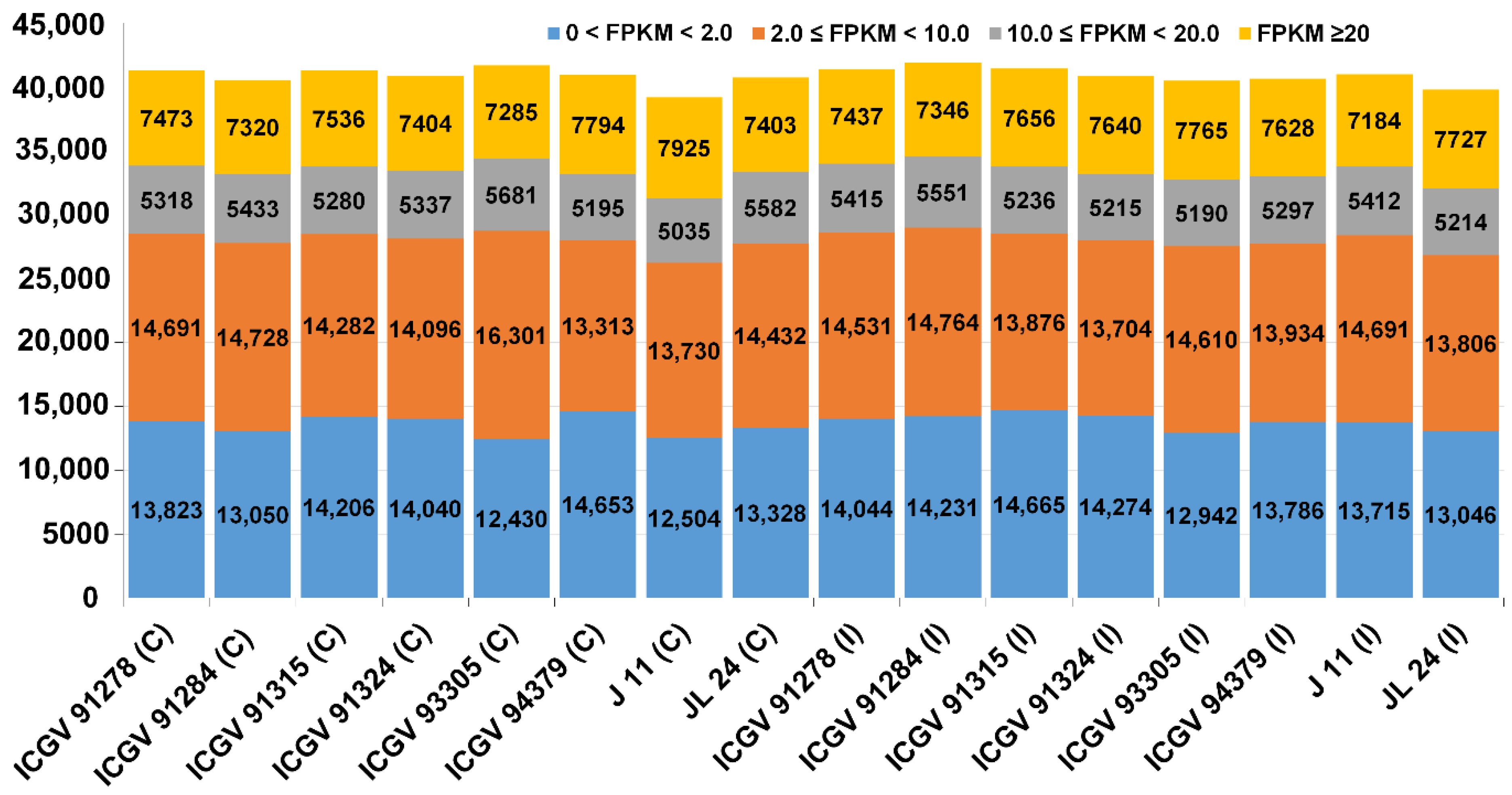
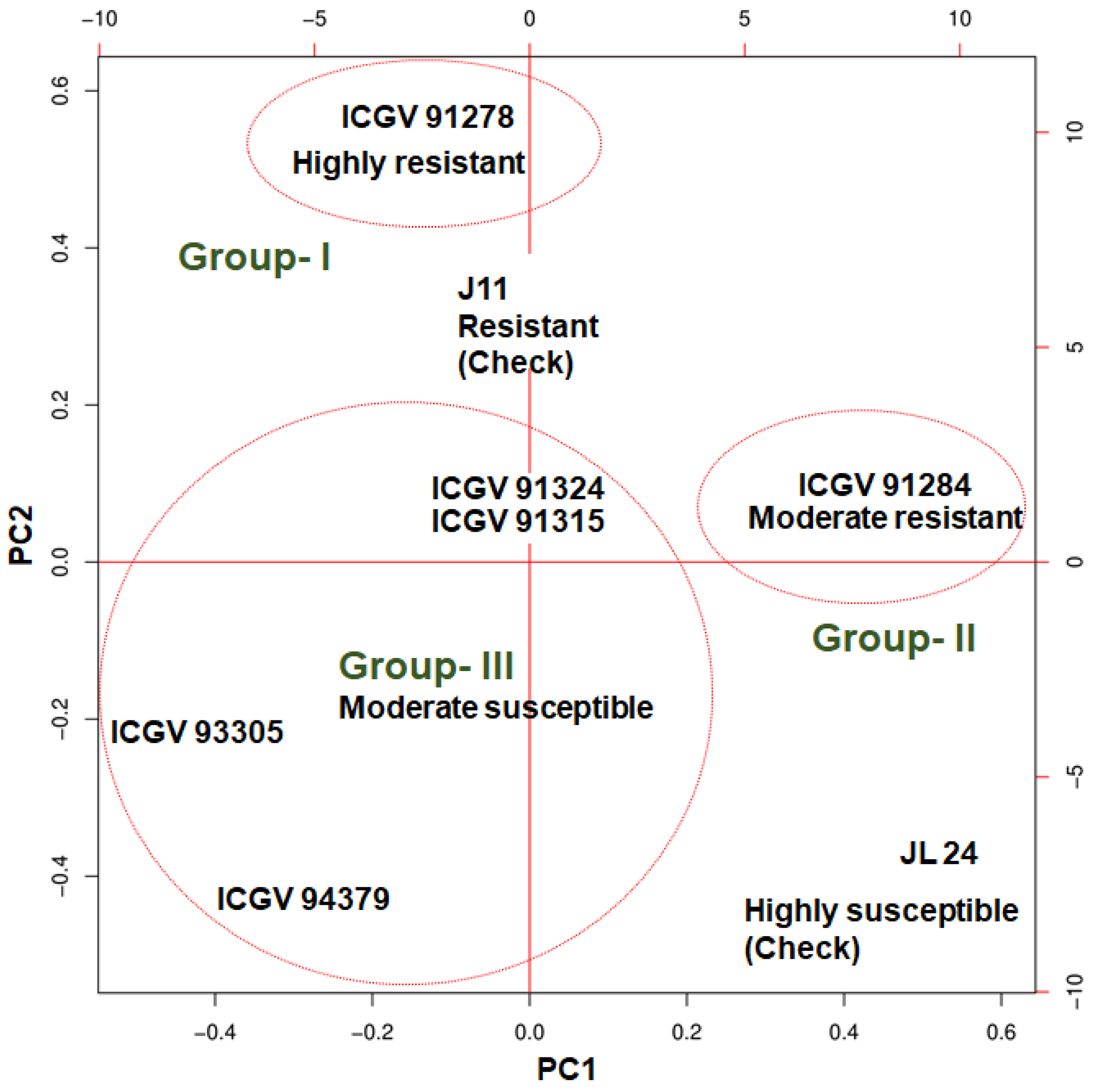
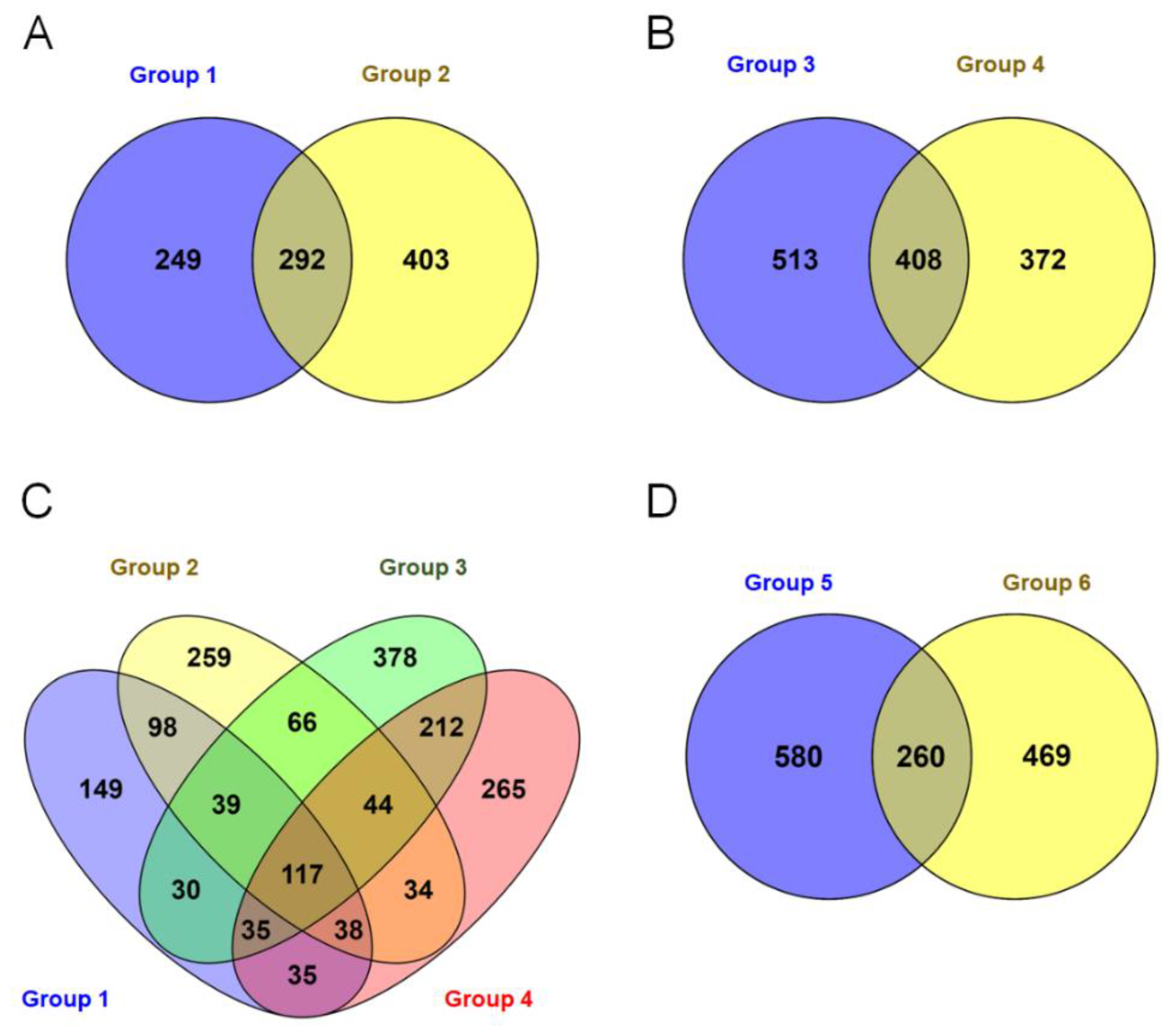

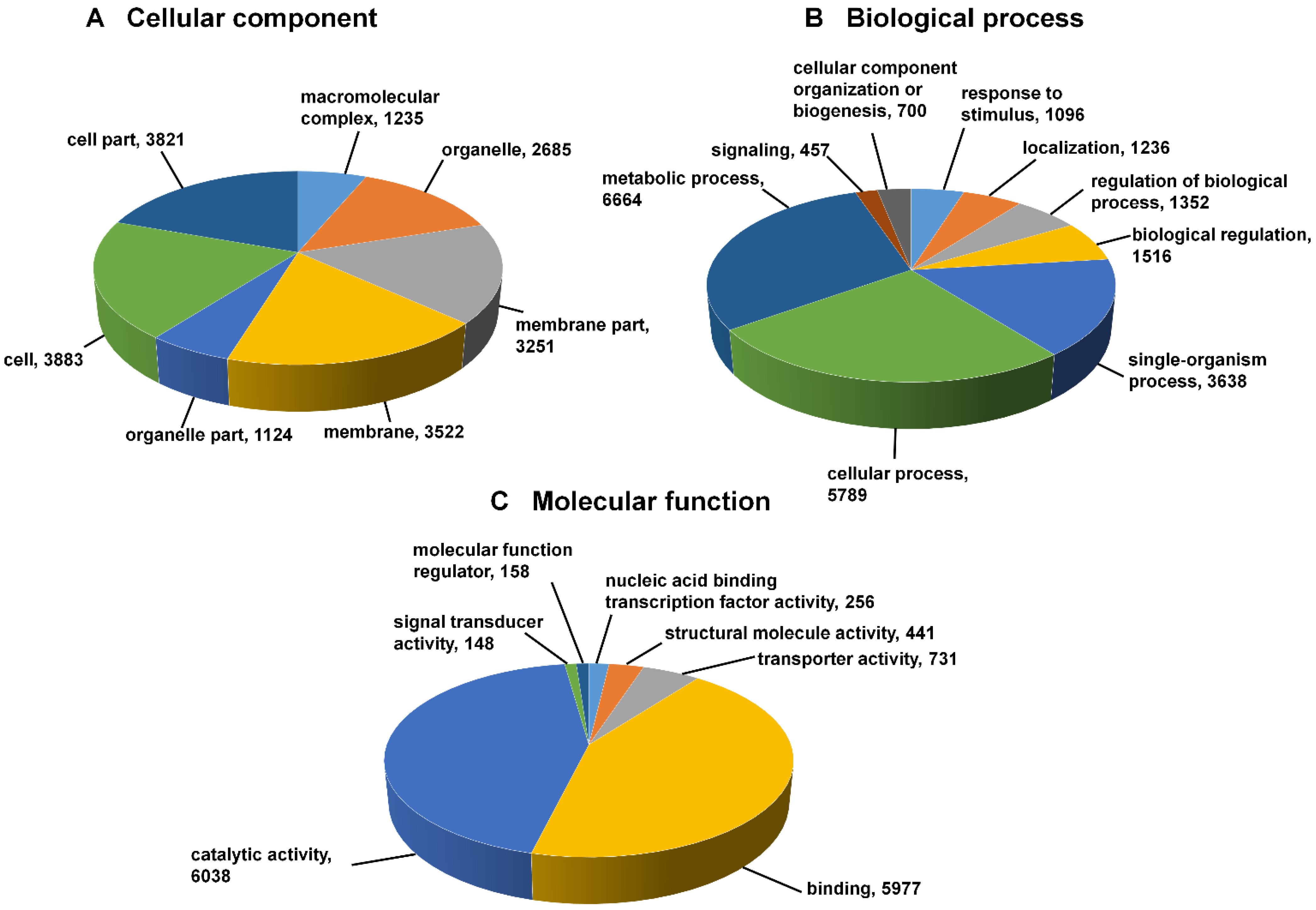
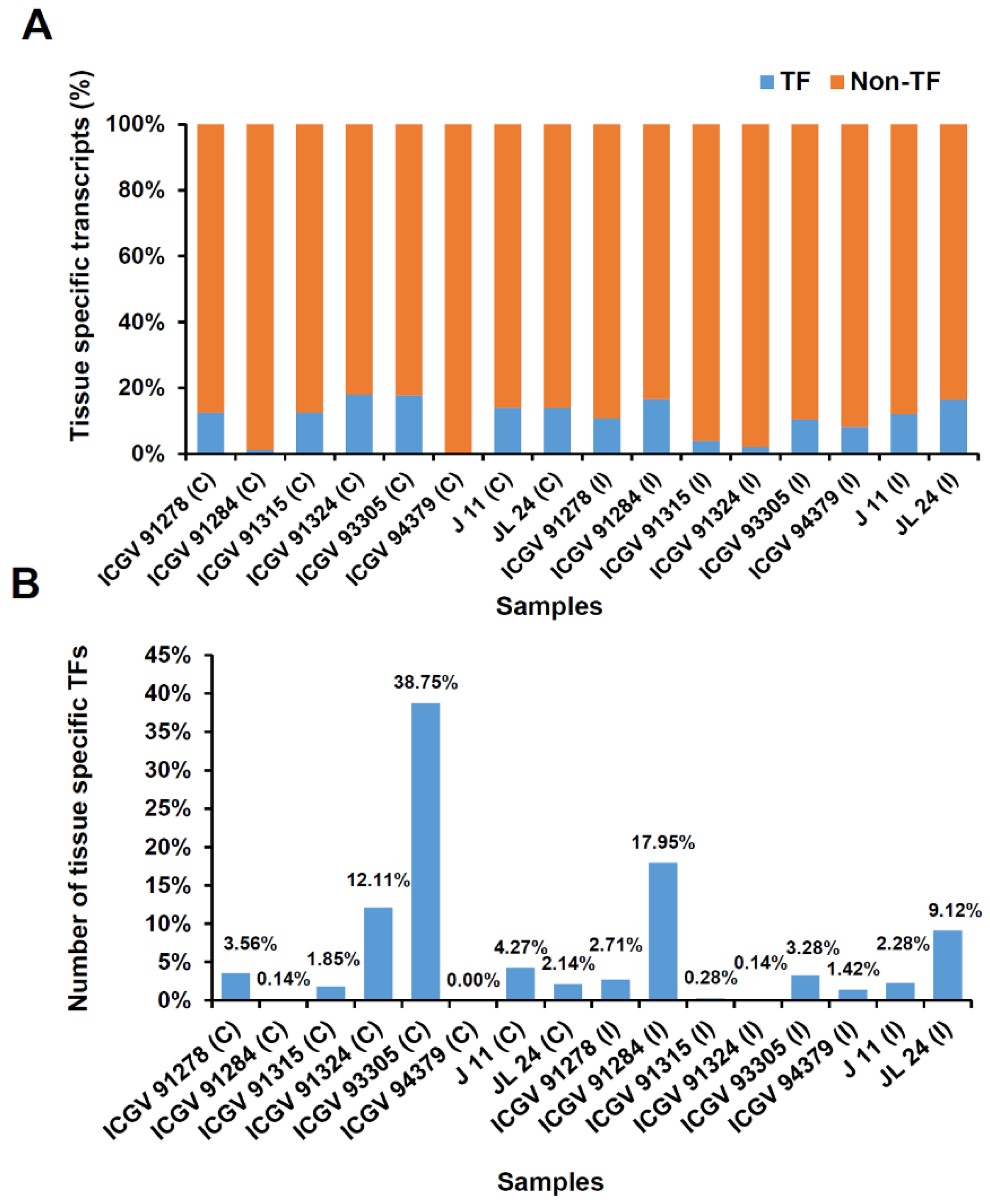

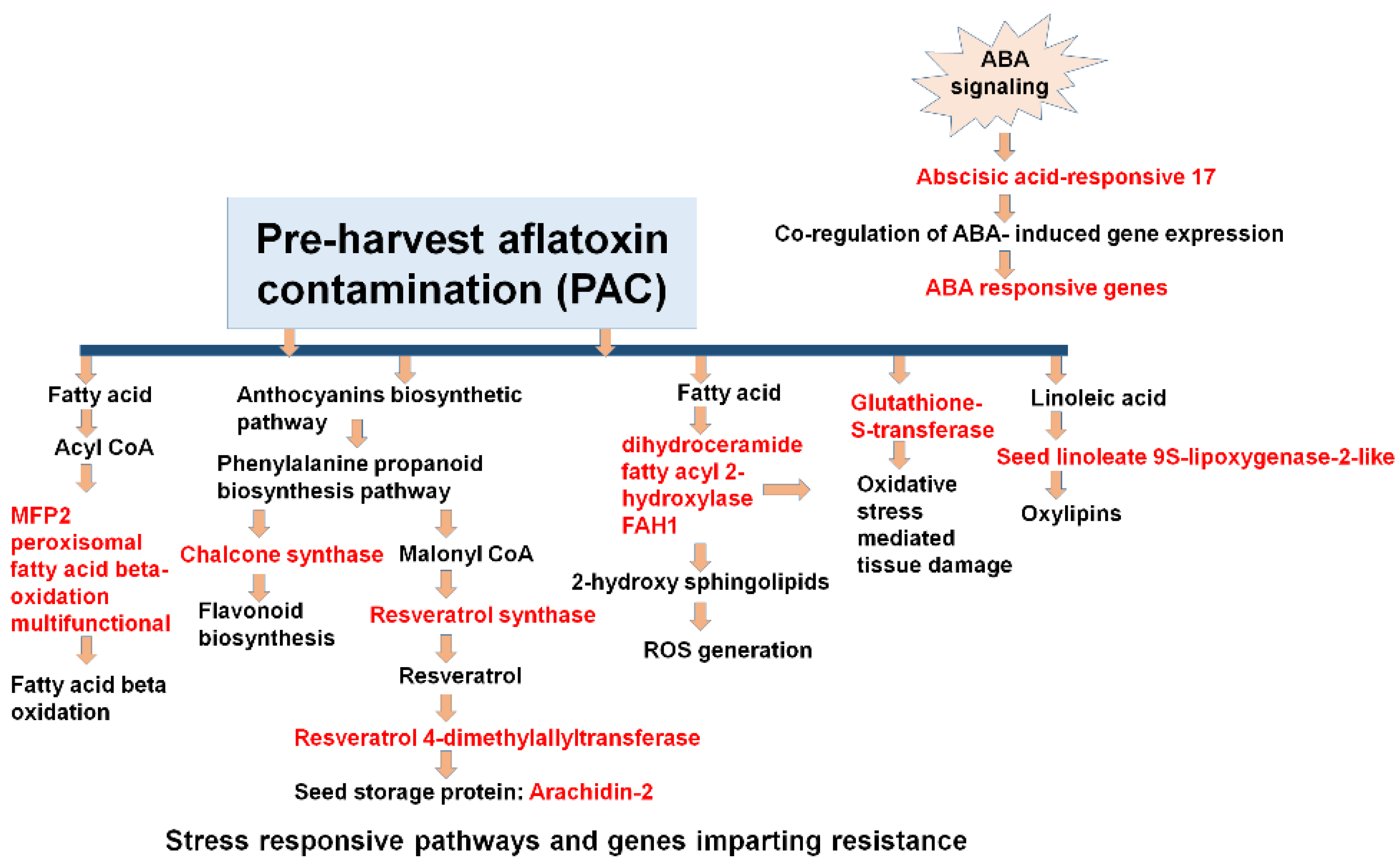
| Sample Name | Total Raw Reads (Millions) | Total QC Reads (Millions) (Q > 20) | Overall Read Mapping (%) |
|---|---|---|---|
| ICGV 91278 (C) | 65.12 | 64.11 | 94.90 |
| ICGV 91284 (C) | 62.03 | 58.89 | 94.80 |
| ICGV 91315 (C) | 65.42 | 63.76 | 94.80 |
| ICGV 91324 (C) | 60.15 | 58.79 | 94.40 |
| ICGV 93305 (C) | 55.24 | 53.00 | 94.20 |
| ICGV 94379 (C) | 82.69 | 80.57 | 94.30 |
| J 11 (C) | 44.60 | 42.62 | 94.80 |
| JL 24 (C) * | 57.92 | 56.55 | 94.20 |
| ICGV 91278 (I) | 58.17 | 56.52 | 94.20 |
| ICGV 91284 (I) | 60.47 | 58.71 | 93.90 |
| ICGV 91315 (I) | 76.38 | 73.46 | 94.30 |
| ICGV 91324 (I) | 58.63 | 56.95 | 94.40 |
| ICGV 93305 (I) | 61.50 | 59.63 | 94.40 |
| ICGV 94379 (I) | 55.80 | 54.31 | 94.10 |
| J 11 (I) | 54.94 | 52.38 | 94.40 |
| JL 24 (I) * | 52.58 | 51.67 | 89.90 |
| Total | 971.63 | 941.93 | - |
| Minimum | 44.60 | 42.62 | 89.90 |
| Maximum | 82.69 | 80.57 | 94.90 |
| Average | 60.73 | 58.87 | 94.13 |
| Parents | Gene ID | Annotation | Expression Values (FPKM) | |
|---|---|---|---|---|
| Control | Infection | |||
| ICGV 91278 | UN_2125 | DEF2_Defensin 2 | 10520.9 | 20643 |
| ARP_1078 | Pathogenesis-related PR-4 isoform X2 | 44.09 | 102.03 | |
| ARD_1670 | Pathogenesis-related 2-like | 16.54 | 84.08 | |
| ICGV 91284 | ARD_2757 | Probable BOI-related E3 ubiquitin-ligase 3 | 10.73 | 15.04 |
| ARP_15581 | Chalcone–flavonone isomerase 1A | 6.84 | 3.29 | |
| ICGV 91315 | UN_4369 | ABA-responsive ABR17 | 16049.7 | 19023.1 |
| ICGV 91324 | ARP_13077 | UDP-glucose flavonoid | 16.9 | 19.36 |
| ARD_12934 | UDP-glucose flavonoid | 19.36 | 24.95 | |
| ICGV 93305 | ARD_2757 | Probable BOI-related E3 ubiquitin-ligase 3 | 9.56 | 24.75 |
| ARP_1078 | Pathogenesis-related PR-4 isoform X2 | 47.09 | 128.9 | |
| ARP_1913 | Probable BOI-related E3 ubiquitin- ligase 3 | 25.9 | 63.27 | |
| ARP_24754 | ABA-responsive ABR17 | 11051.9 | 37685.6 | |
| UN_2125 | DEF2_Defensin 2 | 3289.82 | 19092.1 | |
| UN_4369 | ABA-responsive ABR17 | 16909.2 | 49108.9 | |
| ICGV 94379 | ARD_12934 | UDP-glucose flavonoid | 11.62 | 16.89 |
| ARP_13077 | UDP-glucose flavonoid | 8.54 | 15.55 | |
| ARD_1670 | Pathogenesis-related 2-like | 5.58 | 10.62 | |
| ARD_2757 | Probable BOI-related E3 ubiquitin-ligase 3 | 6.68 | 9.3 | |
| ARP_1913 | Probable BOI-related E3 ubiquitin-ligase 3 | 59.65 | 84.48 | |
| ARP_24754 | ABA-responsive ABR17 | 11532.5 | 27514.8 | |
| UN_2125 | DEF2_Defensin 2 | 1995.02 | 6773.65 | |
| UN_4369 | ABA-responsive ABR17 | 16056.3 | 35167.3 | |
| ARD_13942 | NAD(P)H-dependent 6 -deoxychalcone synthase | 1.38 | 3.63 | |
| J 11 (R) | ARD_12934 | UDP-glucose flavonoid | 16.73 | 25.32 |
| ARP_13077 | UDP-glucose flavonoid | 7.83 | 24.47 | |
| ARD_1670 | Pathogenesis-related 2-like | 2.2 | 49.04 | |
| ARD_2757 | Probable BOI-related E3 ubiquitin-ligase 3 | 11.33 | 17.58 | |
| ARP_1078 | Pathogenesis-related PR-4 isoform X2 | 0.54 | 30.46 | |
| ARP_1913 | Probable BOI-related E3 ubiquitin- ligase 3 | 27.13 | 44.57 | |
| ARP_24754 | ABA-responsive ABR17 | 9734.37 | 12586.6 | |
| UN_2125 | DEF2_Defensin 2 | 1683.17 | 13333.2 | |
| ARD_21521 | Chalcone–flavonone isomerase 2 | 0 | 1 | |
| ARD_21522 | Chalcone–flavonone isomerase 1B-1 | 0 | 0.7 | |
| ARP_15581 | Chalcone–flavonone isomerase 1A | 2.28 | 4.82 | |
| ARD_13942 | NAD(P)H-dependent 6 -deoxychalcone synthase | 2.19 | 4.64 | |
Publisher’s Note: MDPI stays neutral with regard to jurisdictional claims in published maps and institutional affiliations. |
© 2021 by the authors. Licensee MDPI, Basel, Switzerland. This article is an open access article distributed under the terms and conditions of the Creative Commons Attribution (CC BY) license (https://creativecommons.org/licenses/by/4.0/).
Share and Cite
Soni, P.; Pandey, A.K.; Nayak, S.N.; Pandey, M.K.; Tolani, P.; Pandey, S.; Sudini, H.K.; Bajaj, P.; Fountain, J.C.; Singam, P.; et al. Global Transcriptome Profiling Identified Transcription Factors, Biological Process, and Associated Pathways for Pre-Harvest Aflatoxin Contamination in Groundnut. J. Fungi 2021, 7, 413. https://doi.org/10.3390/jof7060413
Soni P, Pandey AK, Nayak SN, Pandey MK, Tolani P, Pandey S, Sudini HK, Bajaj P, Fountain JC, Singam P, et al. Global Transcriptome Profiling Identified Transcription Factors, Biological Process, and Associated Pathways for Pre-Harvest Aflatoxin Contamination in Groundnut. Journal of Fungi. 2021; 7(6):413. https://doi.org/10.3390/jof7060413
Chicago/Turabian StyleSoni, Pooja, Arun K. Pandey, Spurthi N. Nayak, Manish K. Pandey, Priya Tolani, Sarita Pandey, Hari K. Sudini, Prasad Bajaj, Jake C. Fountain, Prashant Singam, and et al. 2021. "Global Transcriptome Profiling Identified Transcription Factors, Biological Process, and Associated Pathways for Pre-Harvest Aflatoxin Contamination in Groundnut" Journal of Fungi 7, no. 6: 413. https://doi.org/10.3390/jof7060413
APA StyleSoni, P., Pandey, A. K., Nayak, S. N., Pandey, M. K., Tolani, P., Pandey, S., Sudini, H. K., Bajaj, P., Fountain, J. C., Singam, P., Guo, B., & Varshney, R. K. (2021). Global Transcriptome Profiling Identified Transcription Factors, Biological Process, and Associated Pathways for Pre-Harvest Aflatoxin Contamination in Groundnut. Journal of Fungi, 7(6), 413. https://doi.org/10.3390/jof7060413










